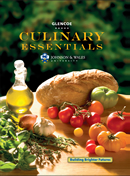
Culinary Essentials ©2010Chapter 11: Culinary NutritionCheck Your Answers: After You ReadSection 11.1Review Key Concepts1. Water-soluble vitamins dissolve in water, so the body loses them each day, and they must be replaced daily. Fat-soluble vitamins are stored in the liver. For this reason, you do not have to consume fat-soluble vitamins every day.2. Coloring agents may be found in cheese, soft drinks, baked items, cereals, and candy. Practice Culinary Academics3. Science Foods containing starch, such as potatoes, should turn a dark blue-black in reaction to the iodine. This is a chemical reaction. Food scientists often use chemistry to determine the nutrients that are in various food items.4. English Language Arts Your posters should be creative, but should also contain substantial information about the nutrients and the sources of the nutrients. The information should be presented in a manner appropriate to a poster for a classroom or work space to teach students or employees about nutrients. 5. Mathematics 41 grams/can × 9 cans = 369 grams of sugar/week. 369 grams ÷ 454 = 0.812775 pounds, so 0.81 pounds of sugar coming from the soda/week. Section 11.2Review Key Concepts1. Nutrition labels provide information on serving size, calories, and nutrients. Nutrients are measured both in grams and the percentage of daily values the product contains.2. Lacto-vegetarians eat or drink some dairy products, such as cheese and milk, but do not eat eggs. Ovo-vegetarians eat eggs in addition to foods from plant sources. Lacto-ovo-vegetarians include dairy and eggs in their diet. Vegans do not eat any meat or animal products. Practice Culinary Academics3. Social Studies The Food Guide Pyramid was developed in 1992 to show basic food groups and their relationships to each other. MyPyramid was introduced in 2005 to update the information in the Food Guide Pyramid and illustrate the Dietary Guidelines for Americans.4. English Language Arts Write your critique in the format and tone of a newspaper column. Explain how the menu meets the government recommendations and point out any areas where it fails to meet the recommendations. Provide some suggestions to the restaurant owner for improvement. 5. Mathematics Wesley should not exceed 93.3 grams of fat per day. 2,800 × 0.3 = 840 fat calories. 840 ÷ 9 = approximately 93.3 grams. Section 11.3Review Key Concepts1. Healthful cooking techniques include steaming, grilling, poaching, stir-frying, and microwaving.2. Replace fat in a dish by replacing part or all of whole eggs with egg whites or egg substitutes, using high-quality reduced-fat products, or using puréed fruits. Practice Culinary Academics3. Science Your report should provide useful information about the product, how it was created or developed, how it addresses a particular health need, and any controversies, benefits, and drawbacks of the product.4. English Language Arts Your demonstration should accurately incorporate information from the section into a presentation that is clear, educational, and appropriate in tone to an audience of working chefs. 5. Mathematics Oat cereal has more fat. One cup of the oat cereal has 3.5 grams ÷ 0.75 = approximately 4.67 grams. One cup of the puffed cereal has 5 grams ÷ 1.25 = 4 grams. |  |















